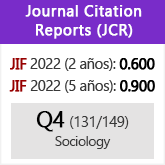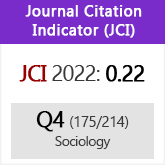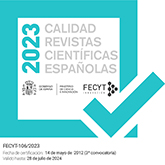Las bases neuronales de la racionalidad limitada
DOI:
https://doi.org/10.3989/ris.2011.10.19Palabras clave:
Beauty contest game, Jerarquía cognitiva, Neuroeconomía, Resonancia magnética funcional (fMRI)Resumen
La racionalidad limitada es un fenómeno observado de manera frecuente tanto en juegos experimentales como en situaciones cotidianas. La Neuroeconomía puede mejorar la comprensión de los procesos mentales que caracterizan la racionalidad limitada; en paralelo nos puede ayudar a comprender comportamientos que violan el equilibrio. Nuestro trabajo presenta resultados recientes sobre la bases neuronales del razonamiento estratégico (y sus límite) en juegos competitivos —como el juego del “beauty contest”. Estudiamos las bases neuronales del comportamiento estratégico en juegos con interacción entre sujetos usando resonancia magnética funcional (fMRI). Las decisiones de los participantes se clasifican acorde al grado de razonamiento estratégico: el llamado modelo de Jerarquías Cognitivas. Los resultados muestran una correlación entre niveles de razonamiento y actividad neuronal relacionada con el “mentalizing”, es decir, con la habilidad para pensar y atribuir pensamientos y estados mentales a otros individuos. Más aun, la actividad cerebral nos muestra que los procesos cognitivos complejos aparecen en los niveles superiores de razonamiento estratégico. Finalmente, nuestro trabajo evidencia que el modelo de Jerarquías Cognitivas describen bien el comportamiento y la actividad cerebral.
Descargas
Citas
Amodio, D.M. and Frith, C.D. 2006. “Meeting of minds: the medial frontal cortex and social cognition.” Nature Review Neuroscience 7:268-277. http://dx.doi.org/10.1038/nrn1884 PMid:16552413
Baron-Cohen, S. 1995. Mindblindness. An Essay on Autism and Theory of Mind. Brandford Books: MIT Press.
Bhatt, M. and Camerer, C.F. 2005. “Self-referential thinking and equilibrium as states of mind in games: fMRI evidence.” Games and Economic Behavior, 52:424-459. http://dx.doi.org/10.1016/j.geb.2005.03.007
Bird, C.M., Castelli, F., Malik, O., Frith, U. and Husain, M. 2004. “The impact of extensive medial frontal lobe damage on ‘Theory of Mind’ and cognition.” Brain 127:914-928. http://dx.doi.org/10.1093/brain/awh108 PMid:14998913
Bosch-Domenech, A., Montalvo, J.G., Nagel, R. and Satorra, A. 2002. “One, two, (three), infinity,: Newspaper and lab beauty-contest experiments.” American Economic Review 92:1687-1701. http://dx.doi.org/10.1257/000282802762024737
Camerer, C.F. and Lovallo, D. 1999. “Overconfidence and excess entry: Experimental evidence.” American Economic Review 89:306-318. http://dx.doi.org/10.1257/aer.89.1.306
Camerer, C.F., Ho, T-H. and Chong, J-K. 2004. “A cognitive hierarchy model of games.” The Quarterly Journal of Economics 119:861-898. http://dx.doi.org/10.1162/0033553041502225
Coricelli, G., McCabe, K. and Smith, V. 2000. “Theory-of-mind mechanism in personal exchange.” Pp.249-259 in Affective Minds, edited by Hatano, et al., London: Elsevier Science.
Coricelli, G. and Nagel, R. 2009. “Neural correlates of depth of social reasoning in medial prefrontal cortex.” Proceeding of the National Academy of Science USA 106:9163-9168. http://dx.doi.org/10.1073/pnas.0807721106 PMid:19470476 PMCid:2685737
Costa-Gomes, M. and Crawford, V.P. 2006. “Cognition and behavior in two-person guessing games: An experimental study.” The American Economic Review 96:1737-1768. http://dx.doi.org/10.1257/aer.96.5.1737
D’Argembeau, A., Ruby, P., Collette, F., Degueldre, C., Balteau, E., Luxen, A., Maquet, P. and Salmon, E. 2007. “Distinct regions of the medial prefrontal cortex are associated with self-referential processing and perspective taking.” Journal of Cognitive Neuroscience 19:935-944. http://dx.doi.org/10.1162/jocn.2007.19.6.935 PMid:17536964
Fletcher, P.C., Happe, F., Frith, U., Baker, S.C., Dolan, R.J., Frackowiak, R.S. and Frith, C.D. 1995. “Other minds in the brain: a functional imaging study of theory of mind´ in story comprehension.” Cognition 57:109-128. http://dx.doi.org/10.1016/0010-0277(95)00692-R
Gallagher, H.L., Happe, F., Brunswick, N., Fletcher, P.C., Frith, U. and Frith, C.D. 2000. “Reading the mind in cartoons and stories: an fMRI study of ‘theory of mind’ in verbal and nonverbal tasks.” Neuropsychologia 38:11-21. http://dx.doi.org/10.1016/S0028-3932(99)00053-6
Gallup, G. G., Jr. 1970. “Chimpanzees: Self-recognition.” Science, 167:86-87. http://dx.doi.org/10.1126/science.167.3914.86
Gigerenzer, G. and Selten, R. 2001. Bounded Rationality: The Adaptive Toolbox. Cambridge, Mass.: MIT Press.
Goldman, A. 1995. “Interpretation Psychologized?” Pp. 74-79 in Folk Psychology: The Theory of Mind Debate edited by M. Davies and T. Stone. Oxford: Blackwell.
Goldman, A. 2001. “Using your mind to read others.” University of Arizona Working Paper.
Gordon, R. M. 1995. “Folk psychology as Simulation?” Pp. 60-73 in Folk Psychology: The Theory of Mind Debate. edited by M. Davies and T. Stone. Oxford: Blackwell.
Hampton, A.N., Bossaerts, P. and O’Doherty, J.P. 2008. “Neural correlates of mentalizing-related computations during strategic interactions in humans.” Proceeding of the National Academy of Science USA 105:6741-6746. http://dx.doi.org/10.1073/pnas.0711099105 PMid:18427116 PMCid:2373314
Ho, T-H., Camerer, C.F and Weigelt, K. 1998. “Iterated dominance and iterated best response in experimental ‘p-Beauty contests’.” The American Economic Review 88:947-969.
Holland, J.H., Holyoak, K.J. and Nisbett, R.E. 1986. Induction: Processes of Inference, Learning, and Discovery. MIT Press.
Keynes, J.M. 1936. The General Theory of Employment Interest and Money. Cambridge University Press: Macmillan.
Koechlin, E. and Summerfield, C. 2007. “An information theoretical approach to prefrontal executive function.” Trends in Cognitive Science 11:229-235. http://dx.doi.org/10.1016/j.tics.2007.04.005 PMid:17475536
McCabe, K., Houser, D., Ryan, L., Smith, V. and Trouard, T. 2001. “A functional imaging study of cooperation in two-person reciprocal exchange.” Proceeding of the National Academy of Science USA 98:11832-11835. http://dx.doi.org/10.1073/pnas.211415698 PMid:11562505 PMCid:58817
McCabe, K. A. 2008. “Neuroeconomics and the economic sciences.” Economics and Philosophy 24: 345-368. http://dx.doi.org/10.1017/S0266267108002010
Mitchell, J.P., Banaji, M.R. and Macrae, C.N. 2005. “The link between social cognition and self-referential thought in the medial prefrontal cortex.” Journal of Cognitive Neuroscience 17:1306-1315. http://dx.doi.org/10.1162/0898929055002418 PMid:16197685
Mitchell, J.P., Macrae, C.N. and Banaji, M.R. 2006. “Dissociable medial prefrontal contributions to judgments of similar and dissimilar others.” Neuron 50:655-663. http://dx.doi.org/10.1016/j.neuron.2006.03.040 PMid:16701214
Moran, J.M., Macrae, C.N., Heatherton, T.F., Wyland, C.L. and Kelley, W.M. 2006. “Neuroanatomical evidence for distinct cognitive and affective components of self.” Journal of Cognitive Neuroscience 18:1586-1594. http://dx.doi.org/10.1162/jocn.2006.18.9.1586 PMid:16989558
Nagel, R. 1995. “Unreveling in Guessing Games: An experimental Study.” The American Economic Review 85:1313-1326.
Povinelli, D. J. 1993. “Recostructing the evolution of mind.” American Psychologist 48:493-509. http://dx.doi.org/10.1037/0003-066X.48.5.493 PMid:8507049
Selten, R. 1998. “Features of experimentally observed bounded rationality.” European Economic Review 42:413-436. http://dx.doi.org/10.1016/S0014-2921(97)00148-7
Simon, H.A. 1957. Models of Man: Social and Rational. New York: Wiley.
Stahl, D.O. and Wilson, P.W. 1995. “On Players’Models of Other Players: Theory and Experimental Evidence.” Games and Economic Behavior 10:218-254. http://dx.doi.org/10.1006/game.1995.1031
Tomasello, M., Kruger, A. and Ratner, H.H. 1993. “Cultural learning.” Behavioral and Brain Sciences 16:495-552. http://dx.doi.org/10.1017/S0140525X0003123X
Woodruff, G. and Premack, D. 1979. “Intentional communication in the chimpanzee: the development of deception.” Cognition 7:333-362. http://dx.doi.org/10.1016/0010-0277(79)90021-0
Descargas
Publicado
Cómo citar
Número
Sección
Licencia
Derechos de autor 2012 Consejo Superior de Investigaciones Científicas (CSIC)

Esta obra está bajo una licencia internacional Creative Commons Atribución 4.0.
© CSIC. Los originales publicados en las ediciones impresa y electrónica de esta Revista son propiedad del Consejo Superior de Investigaciones Científicas, siendo necesario citar la procedencia en cualquier reproducción parcial o total.Salvo indicación contraria, todos los contenidos de la edición electrónica se distribuyen bajo una licencia de uso y distribución “Creative Commons Reconocimiento 4.0 Internacional ” (CC BY 4.0). Puede consultar desde aquí la versión informativa y el texto legal de la licencia. Esta circunstancia ha de hacerse constar expresamente de esta forma cuando sea necesario.
No se autoriza el depósito en repositorios, páginas web personales o similares de cualquier otra versión distinta a la publicada por el editor.

















